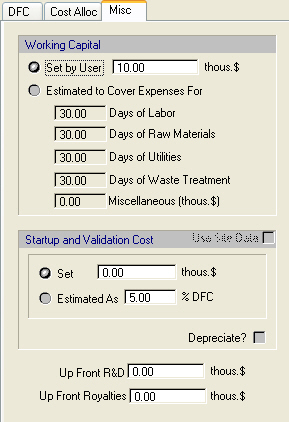

This tab is part of the ‘Capital Investment’ dialog of a process section; for more details, see Capital Investment Dialog.
The following table shows a brief description of the variables appearing in this tab. The table also displays their default values and their generally acceptable range:
|
Variable |
Default Value |
Range |
|
|
||
|
◙ Working Capital (thousand $) |
0.0 |
Positive |
|
○ Days of Labor |
30.0 |
Positive |
|
○ Days of Raw Materials |
30.0 |
Positive |
|
○ Days of Raw Utilities |
30.0 |
Positive |
|
○ Days of Waste Treatment |
30.0 |
Positive |
|
○ Miscellaneous (thousand $) |
0.0 |
Positive |
|
◙ Startup and Validation Cost (thousand $) |
0.0 |
Positive |
|
○ Startup and Validation Cost (% DFC) |
5.0 |
0-100 |
|
○ Up Front R&D (thousand $) |
0.0 |
Positive |
|
○ Up Front Royalties (thousand $) |
0.0 |
Positive |
Symbol Key: ○ User-specified value (always input); ● Calculated value (always output); ◙ Sometimes input, sometimes output
The following list describes the available specification choices in this tab; for more details on how these are implemented, see Total Capital Investment.
•Working Capital...
The section’s working capital can be either:
a) set by the user, or
b) estimated as the sum of major operational costs covered for a certain operating period; these include the costs for labor, raw materials, utilities (i.e., heating/cooling agents and power), waste treatment, and miscellaneous costs; this is the default option of the program.
If the first option is selected, you can specify directly the section’s working capital. If the second option is selected, you can specify the number of days that labor, raw materials, utilities and waste treatment costs are covered by the working capital. The corresponding costs are calculated by multiplying the specified numbers of days by the corresponding unit costs per day; for more details on the unit costs of the above cost items, see Operating Cost. In addition, you can specify a fixed amount of working capital that is attributed to miscellaneous costs. The working capital of a section is calculated as the sum of all the above cost items.
•Startup and Validation Cost...
The section’s startup and validation cost can be either:
a) set by the user, or
b) estimated as a percentage of the section’s DFC; this is the default option of the program.
If the first option is selected, you can specify directly the section’s startup and validation cost. If the second option is selected, the section’s startup and validation cost is calculated by the program based on the specified percentage and the section’s DFC.
|
|
The startup and validation cost may optionally be depreciated; for more details, see Depreciation. |
See also: